Once again, if you want up-to-the-minute coverage of Seattle City Council doings, you've got to bookmark Publicola. They're looking into the Council's proposal to create a transportation benefit district (to assess a $20 annual vehicle fee for transportation improvements that SDOT's leaky budget can't handle). So far Publicola has four or five TBD posts up to...none from anyone else.
Ironically, last year the council repealed a $25 "head tax" that raised $4.5 million each year for transportation improvements, even though SDOT was already facing a deficit. Eight months later, it's time for a new tax to fill the budget hole left by the tax they repealed.
Let's begin at the very beginning: A transportation benefit district (TBD) can be set up by a city or county, creating an independent taxing district for the sole purpose of transportation funding. It can draw revenue from property, sales, and use taxes, and from annual vehicle fees. (Up to $20, vehicle fees don't require a public vote; Lake Forest Park, Edmonds, Des Moines, Olympia, Prosser, and Shoreline have already instituted the $20 yearly fee.)
The council's transportation committee chairman, Tom Rasmussen, proposed the TBD, reports Publicola, who characterize it as an "end run" around Mayor McGinn's transportation plans. In theory, this would raise $6.8 million yearly that the council would collaborate with the Mayor on disbursing....
When I interviewed the UW's Steve Malone back in May, he was looking ahead to this summer's predicted episodic tremor and slip (ETS) event.
Now UW News says the seismic game is afoot once more:
The first ground motion associated with the event was recorded very early Sunday morning in an area north of Olympia and west of Tacoma. By Monday afternoon the signals were substantially stronger. If the event behaves like past occurrences, the source of the rumbling will move north through the Olympic Peninsula during the next week before crossing the Strait of Juan de Fuca to Canada's Vancouver Island.
The seismologists at the Pacific Northwest Seismic Network have installed a huge "array of arrays" (eight arrays with ten seismic recording stations) that should help them "see" downward into the earth and triangulate on where exactly the ETS is emanating from. As I learned in the May interview:
What fascinates seismologists is that this kind of ETS event, in its slow-motion way, unleashes energy equivalent to a 6.5 magnitude quake or greater. It just does it with such nuance that no one noticed until recently.
Nuanced or not, this time the seismologists are dialed in. Hopefully we will soon know a little more about ETS and any connection if may have to our much-anticipated Big One. Scientists still don't know exactly what is going on down there in the subduction zone--it's not clear if the tremor and slip is relieving stress, adding to it, or simply moving it around.
[Ed: Besides taking pictures of major area wildfires on his way to AppleSox games, Seth also turned his attention to old signs while in Wenatchee.]
Perhaps because Wenatchee's main export never goes out of style, the apple orchard-ringed community has enjoyed stable prosperity. No mining busts or plant closings have led to inner city disintegration. Yet no new economy booms have led to inner city revitalization. Thus, many of the city's cool old signs have stuck around, like the guy in your neighborhood with a state pension. Have a look-see!
Open UP is a speaking/discussion forum for people to share their projects and learn how using open source principles and Creative Commons licenses can help them to more effectively collaborate with other like-minded people to build better businesses, lives and communities.
Each Open UP event will feature a variety of speakers who will each get five minutes to present their project and five minutes for Q&A.
All talks will then be uploaded to the Open UP archive for the world to see. After the talks there will be an open discussion where people can network and learn more about incorporating open source ideas and principles into their work. This project is an extremely exciting opportunity for cross pollination and discussion of Open Source Ideals. ...
Because of low clouds, the Blue Angels will be flying their "flat" program today and tomorrow.
You know what you don't hear very often? Good news about Bremerton real estate: "prices expected to increase 44.7 percent from 2010 to 2014."
It's official, La Nina this way comes, and, possibly, a cold, wet, snowy winter. If floods are an issue where you live, start planning now. This fall's work on the Howard Hanson Dam is timely. Senator Patty Murray got the dam repair monies tacked onto an appropriations bill, which I believe is the kind of thing Dino Rossi is against. Just FYI.
Sound Transit is scrambling to quell a ballooning projected deficit, says the Seattle Times. Seattle Transit Blog digs into the numbers.
Transit officials in Seattle consistently under-employ rider information aids, so it's not surprising that light rail station signs are just now beginning to tell riders where the train is going. When an light rail train accident took three hours to clear this week, "certain details, such as the length of delays, didn't make it to passengers." This is a light rail line that serves SeaTac airport, and which in its shake-down year is not experiencing "rare" delays so much as regular ones. But somehow ST's protocol for delays is to let passengers know last, if at all.
Let's go to the neighborhoods for more details on the week. Belltownpeople says au revoir to the Cinerama while it undergoes a two-month 3D upgrade. CHS is looking for witnesses to a public beat-down that happened as the Capitol Hill Block Party was getting started. A Blue Angels sonic boom got the residents of the Central District talking. Beacon Hill was invaded by Spain. RVP has a photo of that light rail v. truck accident....

Firefighter G.F. Sevilles visiting classroom at Halloween, 1966: Item 75723, Seattle Fire Department Slides (Record Series 2801-09), Seattle Municipal Archives
I felt the need to respond to MvB's post about Seattle Schools because I'm no longer "outside looking in" with our school system. I'm a parent now, having endured the process of school selection and the ups and downs of kindergarten.
As an actual SPS parent...I find it amazing any kid gets taught anything at all.
Large school systems are caught in a bind because they have to educate all kids. And educating all kids is the morally correct thing to do. But this leads to what I think are unfair comparisons.
Comparing a charter school to a regular public school is like comparing a boutique to a big box store. Of course the boutique is going to have more of what you want. But it's also going to lack a lot of things you may need because of how specialized it is. And that's been the case with charter schools--when some kid outside their specialization pops up, say a kid with undiagnosed dyslexia, they have nothing to offer for support, but you know, the school district does.
I ran into that shopping for a school last year. I went to what I thought was a fine parochial school, great test scores, diverse, solid teaching...but I mentioned my daughter is showing early signs of ADHD, and it was suddenly: "We can't help you with that; you're on your own." If you're outside of the norm, you're on your own.
Now, it's not that much better with Seattle Public Schools, an organization whose communication style can be best described as "written by unicorns, implemented by Sasquatches, and chaired by the Snuffleupagus." That is, if it exists, I haven't seen it. And I've heard stories of people going to the mat repeatedly with the district just to get help mandated under ADA and the Rehab Act. I've heard stories of parents fighting to get their kids 504 plans written and parents fighting to have the 504s removed from their kids files. On the other hand, at least they have something to fight.
And that's the worrisome part to me about these charter school reformers--they're more than willing to yank their "special snowflakes" out of the public schools, but everyone else's "special snowflakes" with any issues get drop-kicked back into a school system that's now choc-a-bloc with discipline problems, learning disabilities, and kids that cost more to educate than the per capita rate....
The Puget Sound Business Journal has a very good report on Washington state unemployment. As TSB readers know, I'm critical of unemployment "movements" on the order of a tenth of a decimal dutifully parroted as a "drop" or "spike." (Meanwhile, no headline screams "National payroll number for June revised, 221K jobs lost, not 125K.")
Not because of unemployment's valency in political horse-race season, but simply because real-world decisions on things like unemployment extensions hinge on whether politicians and their constituents believe things are getting better or worse.
For context, the last time Washington's well-massaged unemployment rate stood at 8.7 percent was 1992. The dot-com reset crested at 8.3 percent. So if things are any "better" right now, they're also the worst we've seen in eighteen years.
Greg Lamm's PSBJ post tackles another measurement, of overall "labor underutilization" (broken out in categories U-1 to U-6). Category U-6, for instance, includes people who have been out of work so long they have stopped looking or who have taken part-time work just to pay bills. "By that measure, Washington’s unemployment rate was 17.4 percent for a period that spans the third quarter of 2009 and the first two quarters of 2010," writes Lamm....
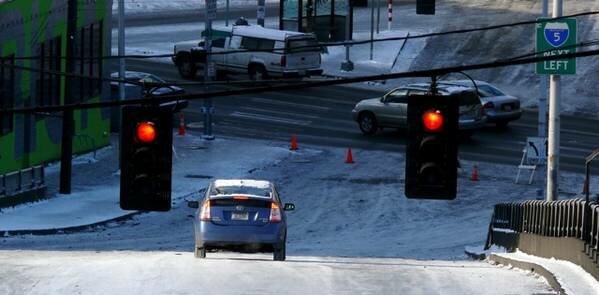 Icy overpass. Closed street blocked by cones. Busy traffic at bottom of hill. A driver decides safety is for other people.
Icy overpass. Closed street blocked by cones. Busy traffic at bottom of hill. A driver decides safety is for other people.
Here is a story from yesterday afternoon: "The mother and children were walking across a controlled crosswalk with flashing lights and bright yellow crossing signs when a vehicle driven by a 31-year-old woman hit the children."
Earlier that day, Wednesday, August 4, Dan Bertolet wrote a post called "Car Hater," in which he referenced the fact that the leading cause of death among children in the U.S. is motor vehicle injuries. Sightline picked up the mini-meme, noting that car accidents are the leading cause of death for anyone under 35.
The point in both cases was for people to reassess their driving habit in light of the inevitable danger involved in piloting a multi-ton vehicle at speed. The safest way to drive is not to drive at all, but no one thinks, on an impulse jaunt to the store, that they've just upped the chances they'll kill someone.
We see people every day--if we're honest, we are those people--who believe in their heart that statistics are for people who don't drive as well as we do. It's easy enough. You assume the brakes will work, the pedestrian won't trip, the light will stay yellow long enough. It's a tragedy of the driving commons.
In 2009, over 6,000 lives were spared when the recession cut down on car trips. Think of that: 6,000 people alive today because someone thought twice about needing to drive somewhere.
 One-on-one instruction, a hallmark of public education
One-on-one instruction, a hallmark of public education
From the Research, Evaluation, and Assessment page of the Seattle School District site, I learn the Seattle school district has a Director of Research, Evaluation & Assessment; a Gates Data Fellow; a Senior Data Analyst; a Program Evaluator/Data Steward; a Assessment Systems Analyst, a Student Information Systems Analyst; and a Lead Education Systems Analyst.
None of these people, I'm told, can tell me how many students are in classrooms, and whether class size has grown over the past ten years.
The district can tell me that in October of 2009, Ballard, Garfield, and Roosevelt all had enrollment of over 1,600 students, but they claim that until this year tracking classroom size was done by principals at each school, and the district did not compile those statistics centrally. (They also can't seem to provide an Excel spreadsheet measuring enrollment against school capacity.)
This is surprising to me because in the district's 2009-10 collective bargaining agreement with the Seattle Education Association (SEA), the district agrees that it will "take actions to limit class size to thirty-two (32) students for core classes in grades 6-12." It would seem odd to agree to that without tracking class sizes. Maybe this can be addressed if and when the SEA goes on strike this fall. As Melinda French Gates says, "Evidence gives you an argument for action."...
In preparation for their Seafair air show August 6-8, the U.S. Navy's Blue Angels are taking some practice runs, which means that in just a few minutes, the I-90 will close to traffic for a good part of the day. Here's the schedule of closures from WSDOT:
- Thursday, Aug. 5: 9:45 a.m. - noon & 1:15 - 2:30 p.m., (Practice)
- Friday, Aug. 6: 12:45 p.m. - 2:40 p.m., (Practice)
- Saturday, Aug. 7: 12:45 p.m. - 2:40 p.m., (Full show)
- Sunday, Aug. 8: 12:45 p.m. - 2:40 p.m., (Full show)
Working my way through the draft of Washington Transportation Plan 2030, I keep coming across what looks like the future arriving today. Unfortunately, it's the future in which the state is broke, but still wants to spend billions on more roads.
"It is noteworthy that approximately 64% of current transportation funding is dependent on how much fuel cars and trucks consume," goes the report, noting at the outset that "the existing 2007-2026 WTP identifies a need to invest more than $67 billion over 20 years (2005 dollars), most of which is unfunded."
With the spike in fuel prices previously and now the recession, people have been driving less, and state revenue from the gas tax has dropped to "E" when it comes to new projects.
Today a Seattle Times headline gives you Exhibit A: "520 bridge shortfall: more tolls, taxes ahead." Even with peak driving time tolls of $3.50 each way, 520 replacement monies fall short. "The forecasts errantly assumed growth in gasoline use, which instead has gone nearly flat," says Mike Lindblom.
It's long been suspected that I-90 will need to be tolled in tandem with 520, which Seattle Senator Ed Murray is in favor of. But no one is jumping on the Coalition for a Sustainable SR 520's funding bandwagon: Their idea is to institute tolls now and a) raise money in advance while b) confirming the effects of $7 daily roundtrip tolls on traffic demand.
The same strategy could be put into effect on SR 99 (aka the Viaduct), since the state plans to toll the deep-bore tunnel as well. But so far the state seems shy about raising money in ways that might affect the rationale for spending billions on new lanes....
In the end, four of Council member Mike O'Brien's five amendments to the deep-bore tunnel resolution ended up little grave markers for political transparency. The Port can non-bindingly say it's in for $300 million. The state can stand firmly behind an unfunded transit component. It's late in the game, and it would have been profoundly surprising to find anyone with a change of heart, let alone two or three votes.
"Full speed ahead," trumpets Tim Burgess on his blog, and if you view boldface, assertion, and boldface assertion as successful rhetorical techniques, you can't help but be persuaded. (Winningly, he adds, "The issue of cost overruns has also been resolved.")
The sturm und drang over the prospect of delay on the Alaskan Way Viaduct Replacement project--the bad delay, not the good delay--aside, no one really cares what the Council thinks. It's more the principle of giving the appearance of looking after Seattle's interests. Learning that two-thirds of Seattle residents really do care how much the tunnel may finally cost, the Council went back to the drawing board to look into the benefits of punting....
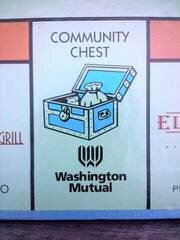 The Benaroya Companies are moving to the Eastside, reports the PSBJ. They're taking up residence in a 79,000-sq.-ft. Benaroya-owned building they've been working on refilling since Zango closed. The short story seems to be that it was easier to pick up stakes and move themselves than find someone to lease the last 8,300 sq. ft. Still, it's a portentous shift, given that Benaroya is the name of Seattle's symphony hall.
The Benaroya Companies are moving to the Eastside, reports the PSBJ. They're taking up residence in a 79,000-sq.-ft. Benaroya-owned building they've been working on refilling since Zango closed. The short story seems to be that it was easier to pick up stakes and move themselves than find someone to lease the last 8,300 sq. ft. Still, it's a portentous shift, given that Benaroya is the name of Seattle's symphony hall.
Meanwhile, mega-developers Schnitzer West have sold two major properties, notes Eric Pryne in the Seattle Times, Bellevue's Advanta Office Commons and Seattle's Equinox apartments née condos. (Equinox and Escala were among the last--if not the last--condo buildings to complete as the downturn shut off financing.) In both sales, Schnitzer West beat the properties' appraised value by wide margins--$75 million for Advanta, and almost $20 million for Equinox.
 And last week Target announced they were coming to Seattle's Pike Plaza, at the foot of the Newmark. Downtown residents rejoiced at the news, and if CHS polls are to be believed, Capitol Hill hipsters think it's just far enough away for them to retain credibility while slinking off-Hill for bargain-shopping.
And last week Target announced they were coming to Seattle's Pike Plaza, at the foot of the Newmark. Downtown residents rejoiced at the news, and if CHS polls are to be believed, Capitol Hill hipsters think it's just far enough away for them to retain credibility while slinking off-Hill for bargain-shopping.
 An inversion collects the smoke from the Jade Mine Road fire in a valley. (Photo: Ron Ewanyshyn, B.C. Wildfire Management)
An inversion collects the smoke from the Jade Mine Road fire in a valley. (Photo: Ron Ewanyshyn, B.C. Wildfire Management)
Over 1,000 British Columbia firefighters are working on a startling 318 forest fires (map) throughout the province. Blame lightning. Numerous evacuation orders are in effect, and a water bomber crash claimed the lives of two men. Drifting to the south, over Seattle, the smoke's milky white haze has people reporting a red sky or golden sun. Of course Cliff Mass has satellite photos from MODIS.
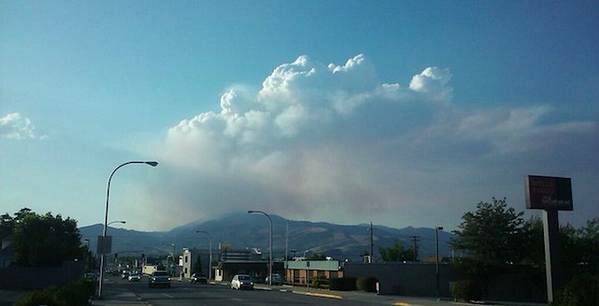 We sent Seth to Wenatchee to cover the fire but he ended up at an AppleSox game instead. (They lost to the Corvallis Knights.)
We sent Seth to Wenatchee to cover the fire but he ended up at an AppleSox game instead. (They lost to the Corvallis Knights.)
It wouldn't be a Friday night in Seattle if someone wasn't shooting a 9mm pistol in the air, would it? As it happens, City Attorney Pete Holmes was just blocks north, walking Belltown with community leaders.
Bank regulators staged a "hold-up" earlier on Friday: Cowlitz and Bay Bank members, meet Heritage Bank. The PSBJ reports that the FDIC retained ownership of $200 million in what are being termed assets. That's Washington's eighth failed bank this year. On the brighter side, U.S. Senator Patty Murray found $44 million to pay for temporary repairs to Howard Hanson Dam, in addition to funding a Seattle-to-Port Townsend passenger ferry. Is it just me, or are election years wonderful?
Target is coming to Seattle, plunking down $15.5 million for retail space at the bottom of Newmark Tower, at Second Avenue between Pike and Union. It's something of a coup, considering that complaints about area crime and disturbances have been constant since the Newmark opened in 1991.
The Hutch announced that as of January 2011 Lawrence Corey, M.D., an expert in virology, immunology and vaccine development, will be their new president and director. The pick seems to emphasize both the relationship of viral infections as cancer-causing agents, and Corey's background in bringing new therapies to bear quickly.
In the neighborhoods, a playground in Eastlake was the terminus for a high-speed chase. Capitol Hill was dealing with a mini-juvenile crime wave. CD News strolled through the new Madison Valley stormwater park, and Southend Seattle explored Deadhorse Canyon. RVP was still celebrating CNN's spotlight on the Columbia City Farmers Market. Viewing portals are going up around the U District light rail station construction....
There's an alarming (or alarmist, depending on your perspective) story coming out of the Washington Brewers' Guild. I caught their press release over at Seattle Beer News, where friend of the site Geoff Kaiser argues forcefully that you should vote "No" on I-1100 (before caveating that he doesn't fully understand all the technicalities discussed), the measure, heavily backed by the beverage industry, to deregulate liquor sales in Washington.
"The problems resulting from Federal deregulation of telecommunication, airline, and banking industries are well known," reads part of the press release. "The affected industries now have reduced competition, less innovation, and benefit only the largest and wealthiest companies. I-1100 eliminates the level playing field that requires consistent pricing for all breweries."
The crux of the argument is essentially that Washington's heavily regulated liquor industry has benefitted the growth of craft brewing by levelling the playing field by limiting tactics big business uses in other states. Volume discounting through distributors could reduce the price of domestics dramatically compared to craft brews, who may even lose their distributors should they be unable to lower prices enough. Also, according to the brewers' association, deregulation would allow "tied houses," bars owned or controlled by a particular brewery.
Still, I find some of the arguments questionable at best. I'm particularly curious about the tied house idea. Ironically, anti-tied house laws were the target of craft brewers only a couple decades ago, because they prevented brewpubs from existing by forcibly separating production from consumer sales. Craft brewers desperately needed that option, since in the absence of large scale production of proven consumer demand distributors weren't interested in them. In other words, repealing essential components of tied house laws allowed brewers to create a successful business model by taking their products directly to the consumer. Perhaps someone more knowledgeable about current regulations can explain what I-1100 will do that, say, Elysian isn't already. Are brewpubs not legally allowed to sell just their own products?...
I happen to know the precise level of genius involved because in January 2008 I took a passenger ferry ride to Port Townsend. Sailings sold out--and this was in the heart of winter.
There was an immediate push at the time to extend what was a temporary arrangement, but no dice. Facing enormous, unsustainable fuel costs for its jumbo ferries, the state was nonetheless "getting out of the passenger ferry business."
Now, Port of Port Townsend officials (Look, how about Port Squared Townsend?) are trying to put the pieces together for a passenger ferry again, and they have gotten help from U.S. Sen. Patty Murray's office.
Recently, Murray recommended that $1 million in federal transportation money be allocated for capital costs associated with setting up a passenger ferry. Final word should come about mid-November, and if all goes well, next summer could bring clear sailing.
Seattle Transit Blog has been following this story for ages: Back in February, Port Townsend "applied for a Federal Highways and Transportation Administration appropriation to buy a small passenger ferry to run commuter trips daily between Port Townsend and Seattle," reported Peninsula Daily News. They were angling for either daily service, or failing that, weekend service for daytrippers, borrowing a 149-passenger catamaran from the Port of Kingston.
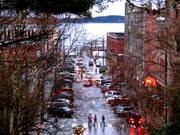 Objections by Jefferson County Commissioner Phil Johnson were that it would a) use fuel, and b) turn Port Townsend into a bedroom community. I think we can safely agree that a) fuel is an accepted expense with ferry service and b) Port Townsend should be so lucky, Mr. Johnson.
Objections by Jefferson County Commissioner Phil Johnson were that it would a) use fuel, and b) turn Port Townsend into a bedroom community. I think we can safely agree that a) fuel is an accepted expense with ferry service and b) Port Townsend should be so lucky, Mr. Johnson.
Officials say that, depending on the boat, the trip could take either one or two hours, and that the smallest boat they'd consider is 69 passengers. One concern is the amount of chop, which is tough on the boat and passengers--it made everyone in my party reach for the Dramamine on the return trip.
But Port Townsend is a great day-trip or weekend destination, no two ways about it. There are sights, food and drink options, and plenty of entertainment. And the mini-cruise it takes to get there only adds to the anticipation.
 As you may know, I like to keep an eye on the motivated sellers on Capitol Hill, as a kind of market barometer. Here's a special case, likely due to financing.
As you may know, I like to keep an eye on the motivated sellers on Capitol Hill, as a kind of market barometer. Here's a special case, likely due to financing.
This one bedroom is on the second floor of a 1924 brick co-op near Seattle University, 1136 13th Ave. Redfin says it's been listed for over a year; Windermere has it selling originally for $175,000, now for $149,000.
It's 600 square feet, with a redone kitchen: granite countertop, slate floor. It comes with a stacked washer/dryer combo, and the HOA dues of $312 include earthquake insurance (because brick, see). It faces south, which is terrific, and there's a large walk-in closet. Downside, baseboard heat, not FHA-approved. I imagine that last is a sticking point for bargain shoppers.
With a 20-percent down payment, your mortgage and HOA could still be under $1,000 per month. And, you have to like the location. At 13th & Union, you're blocks away from everywhere you want to be (i.e., Café Presse and Stumptown, Piecora's, the Pike/Pine corridor, Pony...really, anything fun that begins with "P"). Assuming it doesn't fall down around your ears in the Big One, you're in a good spot.
If you're attending Tristan and Isolde's opening night at Seattle Opera this Saturday, the word from SDOT is to arrive early. Like, 5 p.m. may be good.
Both the Torchlight Parade (7:30 p.m.) and Torchlight Run (6:30 p.m.) conflict with the opera's 6:30 p.m. curtain time. The south side of Seattle Center is a no-go zone; the run crosses Denny twice, closing the street to traffic, so there will be significant congestion.
SDOT suggests--besides arriving very early--that you approach the Seattle Center via Aurora or I-5. Here's what you need to know besides Denny equals "here there be monsters." The parade will be staging on Mercer Street, with one or two lanes open, and will head south down 5th Avenue, then to 4th Avenue.
If you take Aurora, remember the Broad Street exit is closed, so you need to exit on a side street. From I-5, you'll take Broad Street to Harrison to 5th. You'll be able to take 5th Avenue northbound to Roy, if you're heading to the parking garage. Just don't count on traffic moving quickly as the parade time nears.
 Part of the Library's budget now goes to keep all its windows shiny.
Part of the Library's budget now goes to keep all its windows shiny.
In desperate times, the first move is outsource economic responsibility onto a specific, but not-too-vocal "sinning" population. State facing a multi-billion-dollar deficit? Soda-drinkers, gum-chewers, you're up. Library facing cutbacks? Late-returners, whip out the checkbook.
But with desperation driving the change, these responses are not necessarily fair or effective. It's one thing to recoup formerly externalized costs, and in so doing plug a leaky budget. It's another to try to reach into people's wallets for what's handy. Especially when it comes to publicly funded services, like libraries.
On Monday, the Seattle Public Library sent out a news release saying they were "considering" raising fines for overdue materials "to encourage their timely return for use by others and to help offset budget reductions."
But the rest of the release is short on the timely return strategy, and long on how the extra income would help the Library make up for the $3 million in budget cuts they are implementing this year. By "short," I mean there is no evidence provided at all of the scope of late returns, or an estimation of the impact of a $0.10 increase, to $0.25 per day for books, from $0.15. (Fees range depending upon the item borrowed.)...
Construction repairing the west approach of the NE 45th Street Viaduct is right on schedule, says SDOT. The walls are more than 30 percent complete, and the reopening should occur on Friday, September 10, the day before the Huskies' first home game. If this shot has merely whet your appetite, SDOT has been taking their own pictures of the work, and posting them to Flickr.
Escala's news release last Wednesday reported 65 new sales, with 38 closings, in the last three months. That's 38 of a total of 275 units, after the condo tower reopened with prices reduced 20 to 50 percent at the end of March. (Last February, the PSBJ was reporting that only six units had sold, and current King County tax records show just eleven units in private ownership.)
Designed by Thoryk Architecture (Mulvanney G2 were architects of record, and DiLeonardo International, Inc., did the interior design), the 30-floor, $370-million tower from developer Lexas Companies has come down in the world since 2006, when you could "reserve a home" with a $10,000 deposit. (Urbnlivn took the video above, and wrote a review, after touring an open house.)
The idea was to overwhelm Seattle's highest-living with luxury amenities, including a "spa, library, billiard room, theatre/screening room, fitness center with a lap pool, a catering kitchen, a formal dining room, and an events center." There was a marble staircase at the entrance, of course.
In 2007, as the Seattle Times reported, it was the "year of the condo" in Seattle: "Real-estate economist Matthew Gardner shared Thyer's optimism, telling an audience of about 700 that demand for new places to live downtown will remain 'very positive.'"...
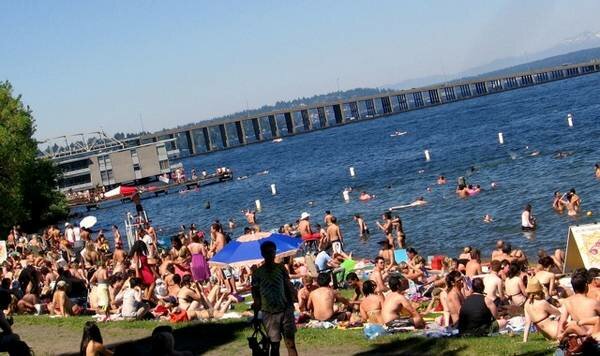 Madison Park's beach is a prime source of Seattle's vitamin D intake.
Madison Park's beach is a prime source of Seattle's vitamin D intake.
Good news from the New York Times: "Given appropriate sun exposure in summer, it is possible to meet the body's yearlong need for vitamin D." Didn't know you could store up the D like a battery, did you? (Fun fact: it's actually a steroid hormone, not a true vitamin--if you get enough sun you don't need another source.)
The consulting physician on the article, Boston U's Dr. Michael Holick, suggests you take sun breaks "from 10 a.m. to 3 p.m. two or three times a week for 5 to 10 minutes." Put sunscreen only on your face, and--think Lady Gaga--maximize your skin exposure.
What's the big idea? Nutritionists have discovered that we aren't getting nearly the amount of vitamin D that we need. While a serious vitamin D deficiency has long been known to cause rickets, it's becoming more evident that chronic low levels of vitamin D can have serious health impacts as well.
Besides documented effects on bone health, Holick references studies that show a lack of vitamin D impacting multiple sclerosis, arthritis, type I diabetes, and immune response in general. Locally, the Fred Hutchinson Cancer Research Center has been researching vitamin D intake and colorectal cancer and breast cancer rates, and have also found that diet, geography, and lifestyle aren't good predictors of individual vitamin D levels; a blood test is the best way to be sure.
Here's the FHCRC line on vitamin D, what it does, how much you need, and how to get it....
I was thinking the other day about the poor state of the Obama Administration and how they'd managed to get so much done and yet only lose ground in the process. The problem, as I see it, is the difference between strategy and tactics when it applies to a military campaign.
Strategy is the overall scope of your battle plan. You will take that hill, then push on to the city below. Tactics are the decisions you make in battle. How will you deploy your troops? How will you send them up the hill? Should you use airpower or artillery?
Obama has a master strategy here--fix a whole bunch of problems that have needed fixing for a while, and fix them permanently. The problem is that politics is entirely about tactics, the daily ebb and flow of the battle. And they're getting outmaneuvered on all sides by the political Right, which is fewer in numbers and shoots themselves in the foot every chance they get, but has managed to keep the Obama Administration so harried they fired a USDA executive last week without stopping to consider the story's origin or veracity.
What does this have to do with Mayor McGinn though? Well, he has the same problem. He has a strategy, but he lacks the tactics to get it done, especially in the face of a City Council emboldened by having a political novice in the executive's chair.
Think about his continual sputtering about the Viaduct. He does have a strategy, and it's not a bad one. He's pulling from the playbook of Fabius Maximus, the great Roman general who was maligned for his strategy against Hannibal. Fabius knew that Hannibal was a tactical genius: At Trasimene Lake, the Carthaginians slaughtered a far larger Roman army because Hannibal used the landscape and surprise to force the Romans out of their battle plan, rendering classical Roman tactics completely useless. Fabius knew Rome could not fight Hannibal's war....
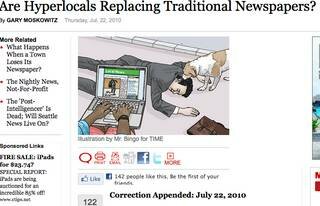 Every time I read a story like TIME's "Are Hyperlocals Replacing Traditional Newspapers?", my first reaction is generally a little thrill of recognition at seeing Tracy Record's name.
Every time I read a story like TIME's "Are Hyperlocals Replacing Traditional Newspapers?", my first reaction is generally a little thrill of recognition at seeing Tracy Record's name.
Seattle's hyperlocal scene (and social media mavenry for that matter) is the envy of the nation, and West Seattle Blog, as a more-than-full-time, news-breaking enterprise is the stuff of future HBR case studies. A six-figure revenue stream in the placeblog space? 750,000 page views per month?
But on the other hand--as Record would be the first to tell you--this is a dog bites man story. Listen to TIME characterize hyperlocal content: "Hyperlocal sites also frequently publish upbeat accounts of parades and high school sports, as well as information on which local vendors sell the best produce. Recent headlines on Record's site noted a 'mega-low' tide and an upcoming garden tour."
What does that sound like? TIME sums it up for you: "Record sits in her living room reinventing the role of an old-school newspaper editor." Reinventing may be stretching it: Record is swimming with the online current, rather than against it, but she's a journalist-editor in the mold of many newshounds who came before her.
 West Seattle Blog is a local newspaper that's not printed on newspaper, but otherwise, what's different is a question of degree, rather than kind. It's supported by local advertisers: insurance and real estate agents, yoga and massage practitioners, car repair shops and dog-walkers (thanks to "Sales Guy," co-publisher, and husband, Patrick Sand). Its online presence makes community-driven (and -supplied) stories that much easier, but news tips are not new. The WSB forum fills in for classifieds, and augments reader contributions.
West Seattle Blog is a local newspaper that's not printed on newspaper, but otherwise, what's different is a question of degree, rather than kind. It's supported by local advertisers: insurance and real estate agents, yoga and massage practitioners, car repair shops and dog-walkers (thanks to "Sales Guy," co-publisher, and husband, Patrick Sand). Its online presence makes community-driven (and -supplied) stories that much easier, but news tips are not new. The WSB forum fills in for classifieds, and augments reader contributions.
Record is fond of reminding people that a blog is just a delivery system. It would be a huge mistake to focus solely on the platform, and overlook the veteran, up-all-night journalist who knocks out stories on the hour. Coming from broadcast journalism, Record seems to have had zero fetishistic attachment to ink-smudged sheets; if there's media (video, audio, social) she hasn't leveraged in her quest to connect readers with WSB, please drop her a line, she'd love to hear about it....
Hello!
Twitter: @thesunbreak | Facebook
iPhone app download (Free!)
Subscribe to The SunBreak
Delivery Options
![]() Subscribe to all SunBreak Stories
Subscribe to all SunBreak Stories
Daily Email Digest of The SunBreak
Most Viewed Stories
Recently in Our Flickr Photo Pool
www.flickr.com
|
Our Facebook Fan Page
Neighborhood Blog News
Niche Blog News
Seattle Weather
Get the SunBreak iPhone App

Download the SunBreak iPhone app for free.






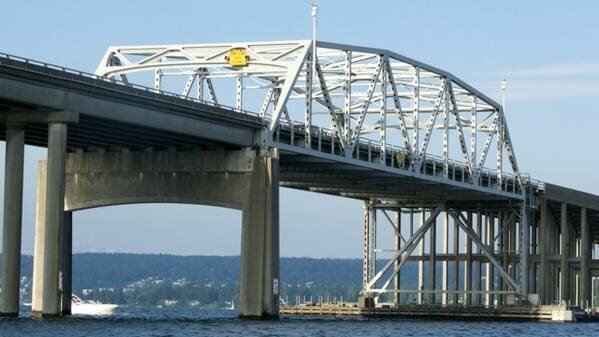
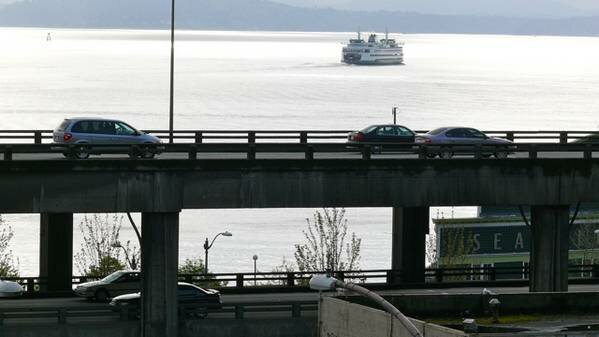


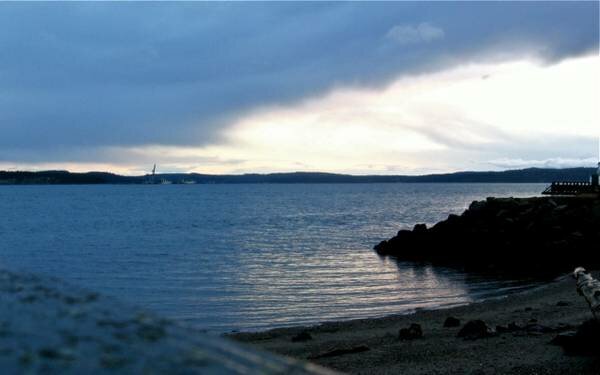


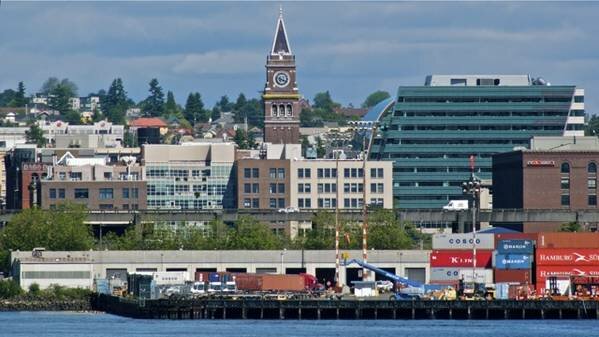


Most Recent Comments